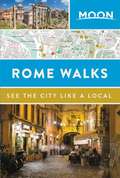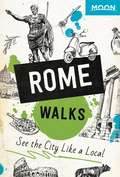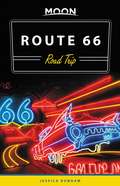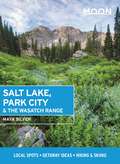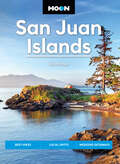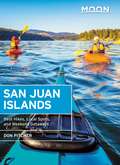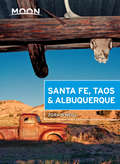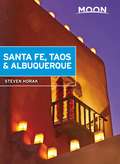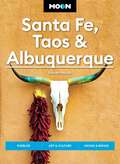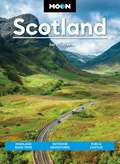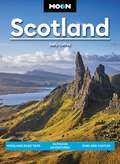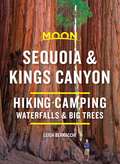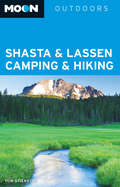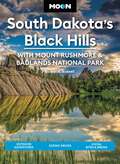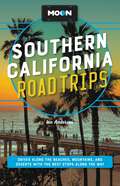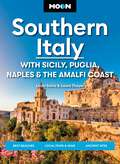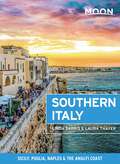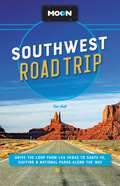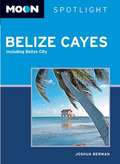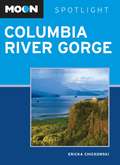- Table View
- List View
Moon Rome Walks
by Moon Travel GuidesExperience Rome like a local: on foot! Enjoy a stroll (or passeggiata) through the bustling streets and cobblestone alleyways of the Eternal City, an ancient capital brimming with vibrant life. This full-color guide features: Six customizable walks through the city's hippest neighborhoods, including Prati, Trastevere, Monti, and more, with color-coded stops and turn-by-turn directions; Foldout maps of each route and a removable full-city map, in a handy, portable guide; Curated "Top Ten" lists for restaurants, famous film locations, Sunday activities, and nightlife; The top attractions and the best-kept local secrets: Wander along winding side streets and find traditional artisans, rare antiques, and trendy boutiques. Walk past the designer displays on Via dei Condotti, take a romantic evening stroll through the Villa Borghese, or people-watch from the Spanish Steps. Admire world-famous works by Bernini and Michelangelo, tour the Roman Forum and the Colosseum, or throw a coin into the Trevi Fountain. Mingle with locals at a Sunday market, find the best neighborhood pizza al taglio or fresh pasta, and discover innovative restaurants, trendy wine bars, and the city's most popular nightclubs. Public transportation options, including the metro, public buses, and taxis. Practical tips for first-time visitors, such as average costs, where you'll need to make a reservation, public holidays, and getting to and from the airport. With creative routes, public transit options, and a full-city map, you can explore Rome at your own pace, without missing a beat.
Moon Rome Walks: See the City Like a Local (Travel Guide)
by Moon Travel Guides<P>Enjoy a passeggiata through the vibrant streets and cobblestone alleyways of the Eternal City, and experience Rome like a local: on foot!<P> <P>Walk through the city's coolest neighborhoods like Prati, Trastevere, Monti, and more, with color-coded stops and turn-by-turn directions<P> <P>Find your scene with top ten lists for restaurants, famous film locations, nightlife, and more<P> <P>Get to know the real Rome: Wander along winding side streets and find traditional artisans, rare antiques, and trendy boutiques. Walk past the designer displays on Via dei Condotti or take a romantic evening stroll through the Villa Borghese. Admire world-famous works by Bernini and Michelangelo, tour the Roman Forum and the Colosseum, or throw a coin into the Trevi Fountain. Mingle with locals at a Sunday market, find the best neighborhood pizza al taglio, and discover innovative restaurants, trendy wine bars, and the city's most popular nightclubs<P> <P>Escape the crowds at locally-loved spots and under-the-radar favorites<P> <P>Explore on the go with foldout maps of each route and a removable full-city map, all in a handy guide that fits in your pocket<P> <P>With creative routes, public transit options, and a full-city map, you can explore Rome at your own pace without missing a beat.<P>
Moon Route 66 Road Trip (Travel Guide)
by Jessica DunhamMoon Route 66 Road Trip reveals the ins and outs of this iconic highway, from sweeping prairies and retro roadside pit-stops to the stunning vistas of the Southwest. Inside you'll find:Maps and Driving Tools: 38 easy-to-use maps detail the existing roads that comprise the original Route 66, along with site-to-site mileage, driving times, detailed directions for the entire route, and full-color photos throughoutEat, Sleep, Stop and Explore: With lists of the best hikes, bites, roadside curiosities, and more, you can admire extraordinary landscapes like Acoma Pueblo or Joshua Tree National Park, explore big cities like Los Angeles and Chicago, or wander abandoned ghost towns. Immerse yourself in classic Americana with outsider art and kitsch masterpieces, find the most Instagram-worthy retro motels, and sample the breadth of regional cuisine, from deep dish pizza to carne asadaFlexible Itineraries: Moon Route 66 Road Trip covers Illinois, Missouri, Kansas, Oklahoma, Texas, New Mexico, Arizona, and California. Drive the entire original Mother Road in two weeks, or follow strategic routes for shorter trips to Chicago, Los Angeles, St. Louis, Santa Fe, and the Grand Canyon, plus side trips to Taos, Las Vegas, Joshua Tree, and Santa MonicaExpert Perspective: Jessica Dunham has driven thousands of miles along the famed highway and provides cultural insight, insider tips, and critical history of the routePlanning Your Trip: Know when and where to get gas and how to avoid traffic, plus tips for driving in different road and weather conditions and suggestions for international visitors, LGBTQ travelers, seniors, road-trippers with kids, and accessibilityWith Moon Route 66 Road Trip's practical tips, detailed itineraries, and tried-and-true expertise, you're ready to fill up the tank and hit the road.Looking for more great American road trips? Try Moon Pacific Northwest Road Trip or Moon California Road Trip.
Moon Salt Lake, Park City & the Wasatch Range: Local Spots, Getaway Ideas, Hiking & Skiing (Travel Guide)
by Maya SilverDiscover brooding mountains, dense forests, and the "greatest snow on earth," just beyond the city limits. Inside Moon Salt Lake, Park City & the Wasatch Range you'll find:Flexible itineraries, from weekends in Salt Lake or Park City to day trips to nearby ski resorts and state parksStrategic advice for outdoors lovers, families, craft beer enthusiasts, festival-goers, and moreOutdoor adventures: Ski the legendary powder at one of Cottonwood Canyons' four resorts, kayak the otherworldly Great Salt Lake, and venture into the vast Uinta Mountains and picnic by a high alpine lake. Climb to the top of Mount Timpanogos for sweeping views, test your nerve on a steep rock-climbing route in Little Cottonwood Canyon, or marvel at the fall color in Wasatch Mountain State ParkMust-see highlights and unique experiences: Immerse yourself the Wild West-meets-Hollywood vibe of Sundance, uncover Mormon history at Temple Square, stroll Ogden's historic main street, and kick back with a craft beer at one of Utah's many emerging breweriesHonest advice from Park City local Maya Silver on when to go, where to eat, and where to stayFull-color photos and detailed maps throughoutFocused coverage of Salt Lake City, Park City, Big and Little Cottonwood Canyons, Ogden, the Great Salt Lake Desert, the Wasatch Back, Oakley, Kamas, and the UintasThorough background on the culture, weather, wildlife, and historyFind your adventure with Moon Salt Lake, Park City & the Wasatch Range.Looking for coverage of the whole state? Try Moon Utah. Exploring nearby? Pick up Moon Zion & Bryce.
Moon San Juan Islands
by Don PitcherWriter and photographer Don Pitcher introduces travelers to the best of the San Juan Islands, from their luxurious inns and upscale restaurants to their evergreen forests and rocky shorelines. Don is the essential tour guide to this popular getaway destination, providing itineraries such as Romantic San Juans, Camping with the Kids, and Exploring the Outer Islands. Complete with details on activities including whale-watching, kayaking, sailing, hiking, and diving,Moon San Juan Islandsgives travelers the tools they need to create a more personal and memorable experience.
Moon San Juan Islands: Best Hikes, Local Spots, Weekend Getaways (Moon U.S. Travel Guide)
by Don Pitcher Moon Travel Guides'Island time' isn't just for the tropics: Escape to evergreen forests, rocky shorelines, and the glittering sea with Moon San Juan Islands. Inside you'll find:Flexible itineraries like a 10-day best of the islands and a weeklong family camping trip, with coverage of gateway towns such as Anacortes, Whidbey Island, and Bellingham, plus nearby Seattle Unique experiences and can't-miss sights: Picnic on cliffs overlooking the ocean or paddleboard on a tranquil lake. Visit local farms filled with fragrant lavender or fluffy alpacas and sip wine or cider at island vineyards. Savor the flavors of the Pacific Northwest at incredible farm-to-table restaurants, sample oysters fresh from the sea, or browse your way through quirky bookstores and funky antique shops The best outdoor adventures: Go sea kayaking or glide through glimmering nighttime waters during a bioluminescence tour. Marvel at the islands' marine life, including orcas, humpback whales, porpoises, and seals, during a whale-watching trip. Sail around the islands or fish for salmon, cod, and halibut. Take a forest hike, spot rare birds, or bike through rolling farm country and along the stunning shorelines Expert advice from former wilderness ranger Don Pitcher on when to go, how to get around, and where to stay, from romantic B&Bs to stunning campsites Full-color photos and detailed maps throughoutThorough information on the landscape, climate, wildlife, and history With Moon's practical tips and local insight, you can experience the San Juan Islands your way. Exploring more of the Pacific Northwest? Check out Moon Coastal Oregon or Moon Columbia River Gorge & Mount Hood.About Moon Travel Guides: Moon was founded in 1973 to empower independent, active, and conscious travel. We prioritize local businesses, outdoor recreation, and traveling strategically and sustainably. Moon Travel Guides are written by local, expert authors with great stories to tell—and they can't wait to share their favorite places with you. For more inspiration, follow @moonguides on social media.
Moon San Juan Islands: Best Hikes, Local Spots, and Weekend Getaways (Travel Guide)
by Don Pitcher'Island time' isn't just for the tropics: Escape to evergreen forests, pebbled shorelines, and the glittering sea with Moon San Juan Islands. Inside you'll find:Flexible itineraries like a 4-day best of the islands and a weeklong family camping trip, with coverage of gateway towns such as Anacortes, Whidbey Island, and Bellingham, plus nearby Seattle and VictoriaUnique experiences and can't-miss sights: Picnic on cliffs overlooking the ocean or paddleboard on a tranquil lake. Spot playful orcas and check out the Whale Museum in Friday Harbor. Visit local farms filled with fragrant lavender or fluffy alpaca and sip wine or cider at island vineyards. Savor the flavors of the Pacific Northwest at incredible farm-to-table restaurants, sample oysters fresh from the sea, or browse your way through quirky book stores and funky antique shopsThe best outdoor adventures: Go sea kayaking alongside whales or glide through glimmering nighttime waters during a bioluminescence tour. Set your sights on the islands' marine life, including killer whales, humpback whales, porpoises, and seals, during a whale-watching trip. Sail around the islands or fish for salmon, cod, and halibut. Take a forest hike, spot rare birds, or bike through rolling farm country and along the stunning shorelinesExpert advice from former wilderness ranger Don Pitcher on when to go, how to get around, and where to stay, from romantic B&Bs to stunning campsitesFull-color photos and detailed maps throughoutThorough information on the landscape, climate, wildlife, and historyWith Moon's practical tips and local insight, you can experience the San Juan Islands your way.Hitting the road? Try Moon Pacific Northwest Road Trip. Seeing more of The Evergreen State? Check out Moon Washington or Moon Seattle.
Moon Santa Fe, Taos & Albuquerque
by Zora O'NeillNew Mexico native Zora O'Neill shares her appreciation for the Land of Enchantment, from exploring Acoma Pueblo-a 12th-century Native American settlement built upon a 367-foot mesa-to hitting the slopes at Taos Ski Valley. O'Neill offers a variety of trip strategies, such as Weekend Getaways, American Indian Heritage, and Not Just Hot Tamales-a guide to sampling the tastiest examples of the region's distinctive cuisine. Full of tips on hiking aspen-covered mountainsides, wandering among crumbling Franciscan churches, and checking out the area's thriving art scene, Moon Santa Fe, Taos, & Albuquerque gives travelers the tools they need to create a more personal and memorable experience.
Moon Santa Fe, Taos & Albuquerque (Travel Guide)
by Steven HorakWhether you're in search of hot peppers, boundary-pushing art, or a scenic mesa hike, explore the Land of Enchantment's unique magic with Moon Santa Fe, Taos & Albuquerque. Inside you'll find:Strategic, flexible itineraries with ideas for art-lovers, outdoor enthusiasts, and more, plus weekend getaways to each of the three citiesThe top experiences and unique activities: Take a hike (for a day or even a week) along aspen-filled mountainsides or ski the thrilling downhill runs of Taos Valley. Check out the vibrant art, film, and music scene in Santa Fe, wander through crumbling Franciscan mission churches, or visit ancient cave dwellings. Uncover New Mexico's countercultural side at quirky stops like the Tinkertown Museum or a ghost town, sample authentic Southwestern cuisine (don't skimp on the hot chiles!), and observe a tribal dance ceremony at one of the state's many pueblosLocal insight from Santa Fe resident Steven HorakHonest advice on when to go, where to stay, and how to get aroundNotable sights outside of the cities, including: Pecos National Historical Park, Los Alamos, Bandelier National Monument, Acoma Pueblo, the Turquoise Trail, the Jemez Mountain Trail, and moreFull-color, vibrant photos and detailed maps throughoutThorough information including background on the landscape, wildlife, climate, and local cultureWith Moon Santa Fe, Taos & Albuquerque's practical tips and local know-how, you can experience New Mexico your way.Exploring more of the Southwest? Try Moon Arizona & the Grand Canyon or Moon Zion & Bryce. Hitting the road? Try Moon Southwest Road Trip.
Moon Santa Fe, Taos & Albuquerque (Travel Guide)
by Steven HorakExperience the art installations, adobe pueblos, and rugged high desert trails of the Land of Enchantment. Inside Moon Santa Fe, Taos & Albuquerque you'll find:Flexible itineraries for art-lovers, outdoors enthusiasts, families, and more, including weekend getaways to each of the three citiesYear-round outdoor adventures: Race down the slopes of Taos Ski Valley or mountain bike through stands of piñon and juniper near Santa Fe. Hike through thick alpine forests, raft the wild rapids of the Rio Grande Gorge, or capture the best view in New Mexico from a hot air balloon. Wander around the archeological sites and cave apartments of Bandelier National Monument, spot elk in Valles Caldera National Preserve, or trek alongside ancient rock carvings at Petroglyph National MonumentTop experiences and unique activities: Mingle with local artists in the vibrant galleries of Santa Fe, visit Georgia O'Keefe's studio at Ghost Ranch, and experience peak relaxation at a world-class spa. Observe a traditional dance ceremony at a pueblo, admire handmade art and jewelry at the Santa Fe Indian Market, and learn about Native American history at one of the region's many cultural museumsTastes of the Southwest: Dive into traditional New Mexican dishes drenched in spicy red and green chile sauces or indulge in a juicy green chile cheeseburger. Sip on a sunset margarita at a mellow open-air bar or taste local spirits in a trendy cocktail lounge. Take a culinary tour of Santa Fe's growing food truck scene or explore Albuquerque's lively beer cultureExpert insight from Santa Fe local Steven HorakHelpful resources on COVID-19 and traveling in New MexicoVibrant full-color photos and detailed maps throughoutBackground information on the landscape, wildlife, climate, and local cultureWith Moon Santa Fe, Taos & Albuquerque's practical tips and local insight, you can experience the best of New Mexico. Exploring more of the Southwest? Try Moon Phoenix, Scottsdale & Sedona or Moon Southwest Road Trip. Hitting the parks? Try Moon Grand Canyon or Moon Zion & Bryce. About Moon Travel Guides: Moon was founded in 1973 to empower independent, active, and conscious travel. We prioritize local businesses, outdoor recreation, and traveling strategically and sustainably. Moon Travel Guides are written by local, expert authors with great stories to tell—and they can't wait to share their favorite places with you.For more inspiration, follow @moonguides on social media.
Moon Santa Fe, Taos & Albuquerque: Pueblos, Art & Culture, Hiking & Biking (Moon U.S. Travel Guide)
by Steven Horak Moon Travel GuidesExplore the eccentric art installations, historic adobe pueblos, and rugged high desert trails of the Land of Enchantment with Moon Santa Fe, Taos & Albuquerque. Inside you'll find:Flexible itineraries for art-lovers, outdoors enthusiasts, and more, including weekend getaways and a six-day road trip to see all three cities Outdoor adventures: Race down the slopes of Taos Ski Valley or mountain bike through stands of piñon and juniper near Santa Fe. Hike through thick alpine forests, raft the wild rapids of the Rio Grande Gorge, or marvel at the best view in New Mexico from a hot air balloon. Wander around the archeological sites and cave apartments of Bandelier National Monument, spot elk in Valles Caldera National Preserve, or trek alongside ancient rock carvings at Petroglyph National Monument Top experiences and unique activities: Mingle with local artists in the vibrant galleries of Santa Fe, visit Georgia O'Keefe's studio at Ghost Ranch, and relax at a world-class spa. Observe a traditional dance ceremony at a pueblo, admire handmade art and jewelry at the Santa Fe Indian Market, and learn about Native American history at one of the region's many cultural museums. Take a scenic ride on a historic steam-driven train or glide above Albuquerque on the longest aerial tram in the Americas Tastes of the Southwest: Dive into traditional New Mexican dishes drenched in spicy red and green chile sauces or indulge in a juicy green chile cheeseburger. Sip on a sunset margarita at a mellow open-air bar or taste local spirits in a trendy cocktail lounge. Take a culinary tour of Santa Fe's growing food truck scene or explore Albuquerque's lively beer culture Expert insight from Santa Fe local Steven Horak Vibrant full-color photos and detailed maps throughoutHelpful background information on the landscape, wildlife, climate, and local culture With Moon Santa Fe, Taos & Albuquerque's practical tips and local insight, you can experience New Mexico your way. Exploring more of the Southwest? Try Moon Phoenix, Scottsdale & Sedona or Moon Southwest Road Trip. Hitting the parks? Try Moon Grand Canyon or Moon Zion & Bryce.About Moon Travel Guides: Moon was founded in 1973 to empower independent, active, and conscious travel. We prioritize local businesses, outdoor recreation, and traveling strategically and sustainably. Moon Travel Guides are written by local, expert authors with great stories to tell—and they can't wait to share their favorite places with you. For more inspiration, follow @moonguides on social media.
Moon Scotland: Highland Road Trips, Outdoor Adventures, Pubs & Castles (Moon Europe Travel Guide)
by Sally Coffey Moon Travel GuidesDramatic landscapes, hauntingly beautiful ruins, and stirring myths and legends: See for yourself why this evocative country has inspired art and folklore for centuries with Moon Scotland. Inside you&’ll find:Flexible itineraries including a journey through the Highlands and islands, day-by-day itineraries in Glasgow and Edinburgh, a tour of Scotland&’s six World Heritage Sites, and more Strategic advice, whether you&’re looking to castle-hop, trace your ancestry, go cliff-diving, or stroll through misty villages Must-see highlights and unique experiences: Walk along Edinburgh's historic Royal Mile, or climb the Arthur's Seat peak. Explore Neolithic burial chambers and rugged archipelagos in the north, follow the Malt Whisky Trail in Speyside, or hop on the West Highland Railway, one of the world&’s most beautiful train rides. Catch a traditional music performance in Glasgow or chat with locals at a corner pub over folk music and a pint. Hike through wild moors and pine forests to deserted villages on Skye, play one of the oldest golf courses in the world, or take a seaplane over Loch Lomond for dramatic views of the Highlands Honest tips from Scotland expert Sally Coffey Full-color photos and detailed maps throughoutBackground information on Scotland&’s landscape, history, and cultural customs In-depth coverage of Edinburgh, Glasgow, Southern, Central, and Northeast Scotland, Loch Lomond, Inverness, Orkney & Shetland, the Central Highlands and the Isle of Skye, and the Outer Hebrides Experience the best of Scotland with Moon&’s practical tips and expert insight. Continuing your journey? Check out Moon Ireland. About Moon Travel Guides: Moon was founded in 1973 to empower independent, active, and conscious travel. We prioritize local businesses, outdoor recreation, and traveling strategically and sustainably. Moon Travel Guides are written by local, expert authors with great stories to tell—and they can't wait to share their favorite places with you. For more inspiration, follow @moonguides on social media.
Moon Scotland: Highland Road Trips, Outdoor Adventures, Pubs and Castles (Travel Guide)
by Sally CoffeyDramatic landscapes, hauntingly beautiful ruins, and stirring myths and legends: See for yourself why this evocative country has inspired art and folklore for centuries with Moon Scotland. Inside you&’ll find:Flexible itineraries including a journey through the Highlands and Islands, day-by-day itineraries in Glasgow and Edinburgh, a tour of Scotland&’s six World Heritage Sites, and more Strategic advice, whether you&’re looking to castle-hop, trace your ancestry, go cliff-diving, or stroll through misty villages Must-see highlights and unique experiences: Walk along Edinburgh's historic Royal Mile, or climb the Arthur's Seat peak. Explore Neolithic burial chambers and rugged archipelagos in the north, follow the Malt Whisky Trail in Speyside, or hop on the West Highland Railway, one of the world&’s most beautiful train rides. Catch a traditional music performance in Glasgow or chat with locals at a corner pub over folk music and a pint. Hike through wild moors and pine forests to deserted villages on Skye, play one of the oldest golf courses in the world, or take a seaplane over Loch Lomond for dramatic views of the Highlands Honest tips from Scotland expert Sally Coffey Full-color photos and detailed maps throughoutBackground information on Scotland&’s landscape, history, and cultural customs Helpful resources on Covid-19 and traveling to Scotland In-depth coverage of Edinburgh, Glasgow, Southern, Central, and Northeast Scotland, Loch Lomond, Inverness, Orkney & Shetland, the Central Highlands and the Isle of Skye, and the Outer Hebrides Handy tools such as visa information, a Scottish phrasebook, and tips for LGBTQ+ travelers, families with kids, and seniors Experience the best of Scotland with Moon&’s practical tips and expert insight. Sticking to the major cities? Check out Moon Edinburgh, Glasgow & the Isle of Skye. About Moon Travel Guides: Moon was founded in 1973 to empower independent, active, and conscious travel. We prioritize local businesses, outdoor recreation, and traveling strategically and sustainably. Moon Travel Guides are written by local, expert authors with great stories to tell—and they can't wait to share their favorite places with you. For more inspiration, follow @moonguides on social media.
Moon Sequoia & Kings Canyon Camping & Hiking
by Ann Marie Brown Tom StienstraNature lovers Tom Stienstra and Ann Marie Brown invite travelers to experience the deep canyons, tall peaks, and awe-inspiring giant sequoia groves of Sequoia National Forest and Kings Canyon National Park. Stienstra and Brown's expert advice and useful camping and hiking tips makeMoon Sequoia & Kings Canyon Camping & Hikingessential for any trip to this high Sierra paradise; and their "best-of" trail and campground lists-including Best Scenic Destinations, Best for Fall Colors, and Best for Redwoods and Sequoias-ensure that novice and experienced outdoors adventurers alike will be able to plan their perfect expedition. Complete with clear directions to each location, detailed destination descriptions, difficulty and quality ratings for each hike, and helpful maps,Moon Sequoia & Kings Canyon Camping & Hikingprovides campers and hikers with all the necessary tools to head outdoors.
Moon Sequoia & Kings Canyon: Hiking, Camping, Waterfalls & Big Trees (Travel Guide)
by Leigh BernacchiAscend towering peaks, take in awe-inspiring views, and get to know some of the oldest, tallest, and rarest living things on Earth with Moon Sequoia & Kings Canyon. Inside you'll find:Flexible Itineraries: Unique and adventure-packed ideas for day hikers, winter visitors, families with kids, campers, and more The Best Hikes in Each National Park: Detailed hike descriptions, trail maps, mileage and elevation gains, and backpacking optionsExperience the Outdoors: Behold greatness at the base of a giant sequoia, stop and smell the wildflowers of Zumwalt Meadow, or savor panoramic views from the summit of Mount Whitney (the highest peak in the continental US!). Strap on snowshoes for a ranger-led winter walk or spelunk your way around otherworldly rock formations in Crystal Cave. Cool off in the mist of a trailside waterfall, conquer the 400-step climb to the top of Moro Rock, and gaze at ink-black skies with unbeatable views of the Milky WayHow to Get There: Up-to-date information on traveling between the parks, gateway towns, park entrances, park fees, and toursWhere to Stay: From RV or tent campgrounds to rustic cabins and all-inclusive lodges, find the best spots to kick back, both inside and outside the parksPlanning Tips: When to go, what to pack, safety information, and how to avoid the crowds, with full-color photos and easy-to-use maps throughoutExpert Insight: Former national park ranger Leigh Bernacchi provides helpful background on the parks' history, geology, conservation efforts, and moreFind your adventure in Sequoia and Kings Canyon national parks with Moon.Exploring more of America's parks? Check out Moon USA National Parks.
Moon Seville, Granada & Andalusia: The Alhambra, Wine & Tapas, Coastal Getaways (Moon Europe Travel Guide)
by Lucas Peters Moon Travel GuidesFrom stunning palaces and vibrant plazas to snowy mountains and warm beaches, soak up the magic of southern Spain with Moon Seville, Granada & Andalusia. Inside you&’ll find:Strategic, flexible itineraries including a two-week grand tour of Andalusia, shorter trips to the Pueblos Blancos or Costa del Sol, and more Must-see highlights and unique experiences: Wander among the intricate tiles and beautiful gardens of Granada&’s Alhambra and marvel at the soaring arches of Cordoba&’s Mezquita-Catedral. Row a boat through Seville&’s Plaza de España, ski in the Sierra Nevada, or relax on a sunny beach. Enjoy a flamenco performance, experience a Semana Santa procession, or party at Carnival in Cadiz The best local flavors: Savor fresh seafood, sample unique tapas, and feast on jamón ibérico. Cool down with refreshing gazpacho or warm up with churros and piping hot chocolate. Attend an olive oil tasting, tour a sherry bodega, or sip local wine Ideas for side trips, including Malaga, Tangier, Gibraltar, Cadiz, the Pueblos Blancos, and more Expert advice from writer and photographer Lucas Peters, who has spent the past two decades traveling in Europe Full-color photos and detailed maps throughoutBackground information on the landscape, history, and cultural customs of each city Handy tools such as visa information, a Spanish phrasebook, and tips for families, travelers with disabilities, women travelers, travelers of color, LGBTQ+ travelers, and seniors Experience the best of southern Spain your way with Moon Seville, Granada & Andalusia. Exploring more of Europe? Check out Moon Portugal or Moon Sicily. Expanding your trip? Try Moon Morocco.About Moon Travel Guides: Moon was founded in 1973 to empower independent, active, and conscious travel. We prioritize local businesses, outdoor recreation, and traveling strategically and sustainably. Moon Travel Guides are written by local, expert authors with great stories to tell—and they can't wait to share their favorite places with you. For more inspiration, follow @moonguides on social media.
Moon Shasta & Lassen Camping & Hiking
by Tom StienstraAvid outdoors explorer Tom Stienstra invites fellow adventurers to visit the backcountry lakes, volcanic rock, and quiet wilderness, of Shasta and Lassen. Moon Shasta & Lassen Camping & Hiking's easy-to-use format and exhaustive coverage includes "best-of" campground and trail suggestions, such as Best for White-Water Rafting, Best Butt-Kickers, and Best for Wildlife-making it easy for beginner and expert oudoors enthusiasts alike to create the camping and hiking experience they're looking for. Complete with clear directions to each location, detailed destination descriptions, difficulty and quality ratings for each hike, and helpful maps,Moon Shasta & Lassen Camping & Hikingprovides campers and hikers with all the necessary tools to head outdoors.
Moon South Dakota's Black Hills: Outdoor Adventures, Scenic Drives, Local Bites & Brews (Travel Guide)
by Laural A. BidwellExperience the open skies of the Badlands, the rolling prairies of the West, and one of America's most famous monuments with Moon South Dakota's Black Hills. Inside you'll find:Flexible itineraries: Unique and adventure-packed ideas for day trips, a week on the road, families with kids, wildlife enthusiasts, and more The best hikes in the Black Hills and Badlands, with individual trail descriptions, elevation gains, and trailheads Experience the outdoors: Go horseback riding, rock climbing, backpacking, kayaking, biking, and more. Say hello to the carved granite faces of the presidents and hike red rock canyons and hills covered in ponderosa pine. Spot bison, elk, and mountain goats and see wild horses roaming the grassy flatlands. Climb the tallest peak east of the Rockies or navigate the underground passages of Wind Cave National Park Respectfully connect with Native American culture: Visit historic sites, galleries, and museums to learn about Lakota history, see the Crazy Horse Memorial, or attend a powwow ceremony to watch traditional dances and sample authentic cuisine How to get there: Up-to-date information on gateway towns, park entrances, park fees, and tours Where to stay: Campgrounds, resorts, hotels, and more Planning tips: When to go, what to pack, safety information, and how to avoid the crowds, with full-color photos and detailed maps throughout Expertise and know-how: Experience the best of this stunning region with Laural A. Bidwell, a local of South Dakota's Black Hills Get to know South Dakota your way with Moon. Craving more of the great outdoors? Check out Moon USA National Parks, Moon Zion & Bryce, or Moon Yellowstone & Grand Teton. About Moon Travel Guides: Moon was founded in 1973 to empower independent, active, and conscious travel. We prioritize local businesses, outdoor recreation, and traveling strategically and sustainably. Moon Travel Guides are written by local, expert authors with great stories to tell—and they can't wait to share their favorite places with you. For more inspiration, follow @moonguides on social media.
Moon Southern California Road Trips: Drives along the Beaches, Mountains, and Deserts with the Best Stops along the Way (Travel Guide)
by Ian AndersonHit the beach, hike hidden trails, or soak up some desert sun: the outdoor adventures are endless with Moon Southern California Road Trips.Pick Your Road Trip: Find flexible getaways throughout SoCal like three-day routes up the coast, through Death Valley, Ojai, and more, or combine them for an epic two-week driving tour Eat, Sleep, Stop and Explore: With lists of the best beaches, hikes, wineries, and more, you can tour backlots in Los Angeles, feel like a kid again at Disneyland, and feast on tacos and craft beer in San Diego. Climb Joshua Tree's rock formations to stunning views, ski and surf in the same day, and get a taste of the laidback lifestyle in Santa Barbara and Palm Springs Maps and Driving Tools: Easy-to-use maps keep you oriented on and off the highway, along with site-to-site mileage, driving times, detailed directions, and full-color photos throughout Local Expertise: San Diego native, brew enthusiast, and avid surfer Ian Anderson shares his tips on where to stop and what to see How to Plan Your Trip: Know when and where to get gas and how to avoid traffic, plus tips for driving in different road conditions and suggestions for LGBTQ travelers, seniors, travelers of color, and road-trippers with kids Coverage of Los Angeles, Disneyland, beaches from Malibu to La Jolla, San Diego, Anza Borrego State Park, Palm Springs & Joshua Tree, Route 66, Santa Barbara, San Luis Obispo, and Hearst Castle, plus Las Vegas With flexible itineraries for weekend getaways and practical tips for driving the full loop, Moon Southern California Road Trips gets you ready to fill up the tank and hit the road. Spending more time in the city? Check out Moon 52 Things to Do in Los Angeles. Want to extend your adventure? Check out Moon Northern California Road Trips.
Moon Southern Italy: Best Beaches, Local Food & Wine, Ancient Sites (Moon Europe Travel Guide)
by Laura Thayer Moon Travel Guides Linda SarrisFrom the pastel rooftops of Positano to the soaring peak of Mount Etna, immerse yourself in la dolce vita with Moon Southern Italy. Inside you'll find:Flexible itineraries for exploring the best of Southern Italy, including Naples, Pompeii, Sicily, Puglia, the Amalfi Coast, and more, that can be combined for a longer trip Must-see highlights and unique experiences for any season: Dive into the art museums and traditional theater of Palermo&’s Centro Storico and admire the Baroque monuments and carved churches of Lecce. Walk the frozen-in-time streets of Pompeii and marvel at the captivating Cathedral of Amalfi. Take an off-road Jeep tour of Mount Etna or hike along the coastline. Soak up the sun on a secluded beach or sail the crystal-clear Mediterranean waters The best local flavors: Stroll quiet village streets where the scent of Sunday ragu fills the air, feast on fresh seafood from a bustling outdoor market, and chow down on authentic Neapolitan pizza. Sip limoncello on a sunny terrace or sample wines from the mineral-rich local vineyards Expert suggestions from local authors Laura Thayer and Linda Sarris on where to stay, what to eat, and how to get around Full-color photos and detailed maps throughoutBackground information on the landscape, history, and cultural customs, plus an Italian phrasebook With Moon&’s practical tips and local insight on the best things to do and see, you can experience the very best of Southern Italy. Exploring more of Italy? Check out Moon Rome, Florence & Venice.About Moon Travel Guides: Moon was founded in 1973 to empower independent, active, and conscious travel. We prioritize local businesses, outdoor recreation, and traveling strategically and sustainably. Moon Travel Guides are written by local, expert authors with great stories to tell—and they can't wait to share their favorite places with you. For more inspiration, follow @moonguides on social media.
Moon Southern Italy: Sicily, Puglia, Naples & the Amalfi Coast (Travel Guide)
by Laura Thayer Linda SarrisFrom the pastel rooftops of Positano to the soaring peak of Mount Etna, immerse yourself in la dolce vita with Moon Southern Italy. Inside you'll find:Flexible itineraries for exploring the best of Southern Italy, including Sicily, Puglia, Naples, the Amalfi Coast, and more, that can be combined for a longer trip Strategic advice for foodies and oenophiles, art lovers, hikers, history buffs, beach bums, and more Must-see highlights and unique experiences for any season: Dive into the art museums and traditional theater of Palermo&’s Centro Storico, and admire the Baroque monuments and carved churches of Lecce. Walk the frozen-in-time streets of Pompeii and marvel at the captivating Cathedral of Amalfi. Take an off-road Jeep tour of Mount Etna or hike along the coastline. Soak up the sun on a secluded beach or sail the crystal-clear Mediterranean waters The best local flavors: Stroll quiet village streets where the scent of Sunday ragu fills the air, feast on fresh seafood from a bustling outdoor market, and chow down on authentic Neapolitan pizza. Sip limoncello on a sunny terrace or sample wines from the mineral-rich local vineyards Expert suggestions from Amalfi local Laura Thayer and Palermo local Linda Sarris on where to stay, where to eat, and how to get around Full-color photos and detailed maps throughoutHelpful resources on COVID-19 and traveling to Southern Italy Background information on the landscape, history, and cultural customs Handy tools including an Italian phrasebook and tips for seniors and traveling with children With Moon&’s practical tips and local insight on the best things to do and see, you can experience the very best of Southern Italy. Exploring more of Italia? Check out Moon Milan & Beyond with the Italian Lakes or Moon Rome, Florence & Venice. About Moon Travel Guides: Moon was founded in 1973 to empower independent, active, and conscious travel. We prioritize local businesses, outdoor recreation, and traveling strategically and sustainably. Moon Travel Guides are written by local, expert authors with great stories to tell—and they can't wait to share their favorite places with you. For more inspiration, follow @moonguides on social media.
Moon Southwest Road Trip: Drive the Loop from Las Vegas to Santa Fe, Visiting 8 National Parks along the Way (Travel Guide)
by Tim HullWind-carved red rocks, brightly-painted adobe houses, and miles of open desert road: explore the beauty of the Southwest with Moon Southwest Road Trip. Inside you'll find:Flexible itineraries: Drive the entire two-week road trip, or follow strategic routes like a Route 66 road trip or a week-long tour of the national parks, or plan a shorter getaway to Las Vegas, the Grand Canyon, Zion and Bryce, Arches and Canyonlands, Santa Fe, or TaosEat, sleep, stop and explore: With lists of the best hikes, views, and more, you can marvel at the sandstone spires of Monument Valley and the cliff dwellings of Mesa Verde National Park, go mountain biking in Moab, or swimming in Havasu Falls. Revel in the glitz of Las Vegas, shop the markets of Santa Fe, and dig in to delicious southwestern cuisine Maps and driving tools: 32 easy-to-use maps keep you oriented on and off the highway, along with site-to-site mileage, driving times, detailed directions for the entire route, and full-color photos throughout Local expertise: Road warrior and Arizona local Tim Hull shares his love of the Southwest (including where to find the best fiery chiles!) Planning your trip: Know when and where to get gas, how to avoid traffic, tips for driving in different road and weather conditions With Moon Southwest Road Trip's practical tips, flexible itineraries, and local know-how, you're ready to fill up the tank and hit the road. Looking for more scenic road trips in America? Try The Open Road. Spending more time in the Southwest? Check out Moon Arizona & the Grand Canyon, Moon New Mexico, or Moon Utah.About Moon Travel Guides: Moon was founded in 1973 to empower independent, active, and conscious travel. We prioritize local businesses, outdoor recreation, and traveling strategically and sustainably. Moon Travel Guides are written by local, expert authors with great stories to tell—and they can't wait to share their favorite places with you. For more inspiration, follow @moonguides on social media.
Moon Southwest Road Trip: Las Vegas, Zion & Bryce, Monument Valley, Santa Fe & Taos, and the Grand Canyon (Travel Guide)
by Tim HullWind-carved red rocks, brightly-painted adobe houses, and miles of open desert road: explore the beauty of the Southwest with Moon Southwest Road Trip.Maps and Driving Tools: More than 30 easy-to-use maps keep you oriented on and off the highway, along with site-to-site mileage, driving times, detailed directions for the entire route, and full-color photos throughoutEat, Sleep, Stop and Explore: With lists of the best hikes, views, and more, you can revel in the glitz of Las Vegas, shop the markets of Santa Fe, and savor flavorful Tex-Mex cuisine. Marvel at the sandstone spires of Monument Valley and the cliff dwellings of Mesa Verde National Park, or go mountain biking in Moab or swimming in Havasu FallsFlexible Itineraries: Drive the entire two-week road trip, or follow strategic routes like a Route 66 road trip or a week-long tour of the national parks, as well as suggestions for spending time in Las Vegas, the Grand Canyon, Zion and Bryce, Arches and Canyonlands, Santa Fe, and TaosLocal Expertise: Road warrior and Arizona local Tim Hull shares his love of the Southwest How to Plan Your Trip: Know when and where to get gas and how to avoid traffic, plus tips for driving in different road and weather conditions and tips for seniors, road-trippers with kids, and disability accessMoon Southwest Road Trip covers: New Mexico, Colorado, Utah, Arizona, and Nevada With Moon Southwest Road Trip's practical tips, flexible itineraries, and local know-how, you're ready to fill up the tank and hit the road.Looking to explore more of America on wheels? Try Moon California Road Trip. Spending more time in the Southwest? Check out Moon Arizona & the Grand Canyon, Moon New Mexico, or Moon Utah.
Moon Spotlight Belize Cayes: 2011
by Joshua BermanMoon Spotlight Belize Cayes is an 80-page compact guide covering Belize City, San Pedro, Ambergris Caye, Caye Caulker, Turneffe Islands Atoll, Lighthouse Reef Atoll, and several other northern cayes. Author Joshua Berman offers his firsthand advice on must-see attractions, and includes maps with sightseeing highlights so you can make the most of your time. This lightweight guide is packed with recommendations on entertainment, shopping, recreations, accommodations, food, and transportation, making navigating this vacation hotspot uncomplicated and enjoyable.
Moon Spotlight Columbia River Gorge
by Ericka ChickowskiMoon Spotlight Columbia River Gorgeis a 60-page compact guide covering the best of this spectacular geological wonder of the Pacific Northwest. Award-winning travel writer Ericka Chickowski offers her firsthand advice on must-see attractions, as well as maps with sightseeing highlights, so you can make the most of your time. This lightweight guide is packed with recommendations on entertainment, shopping, recreation, accommodations, food, and transportation, making navigating this region of incredible wilderness and artistic attractions uncomplicated and enjoyable.
